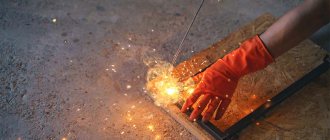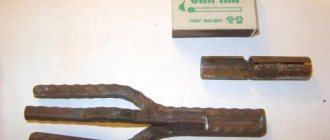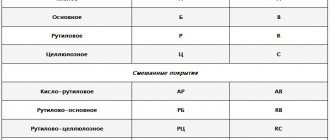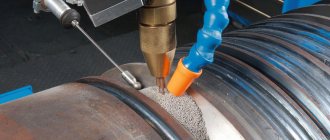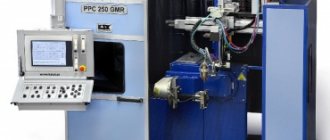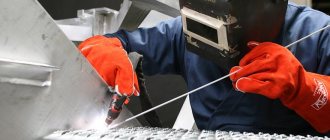To get a high-quality and reliable welding seam, you need to understand which electrodes are best to use and which mode of manual arc welding to choose. In addition, it is important to take into account other equally significant factors, such as: the composition and thickness of the metal, the dimensions of the workpiece being welded, and for what purposes it will be used in the future.
In general, the welding mode is selected according to many factors and after analyzing the data obtained. In this article on the site, we will consider the main factors that, to one degree or another, can influence the choice of mode.
Welding mode selection
So, what factors influence the choice of one or another mode of manual arc welding. First of all, this is:
- Current strength;
- The diameter of the electrodes used and the length of the welding arc;
- Welding speed;
- Polarity (read more about what reverse and direct polarity does here);
- Number of connections.
The main criteria when choosing a mode for MMA welding, of course, is determined by the burning nature of the welding arc, the stability of which depends on how correctly the current strength is selected for some specific electrodes. The higher the current, the larger the diameter of the electrodes you can weld thick metal. In simple words, high currents ensure better arc burning and good heating of the metal.
You should know that when a seam is applied vertically, the current strength changes less than when applied horizontally, by about 15%. For ceiling seams, the value of the welding current will be even less, by about 20%. Very often, values regarding the current strength are on the packaging with electrodes. In addition, you can determine what current strength to set on the welding machine from the table below with the values.
Average welding current (A):
- Electrode diameter (1.6 mm) - electrode with rutile and basic coating (30-55 A) and (50-75 A);
- Electrode diameter (2 mm) - electrode with rutile and basic coating (40-70 A) and (60-100 A);
- Electrode diameter (2.5 mm) - electrode with rutile and basic coating (50-100 A) and (70-120 A);
- Electrode diameter (3 mm) - electrode with rutile and basic coating (80-130 A) and (110-150 A);
- Electrode diameter (4 mm) - electrode with rutile and basic coating (120-170 A) and (140-200 A);
In turn, in order to correctly determine the diameter of the electrode, it is necessary to take into account the thickness of the metal, the welding method and the geometric location of the seam. So, for example, for each electrode its own “own” current value is selected. If you greatly increase its performance, you can easily burn through the metal or, conversely, not achieve a high-quality and reliable weld.
Content
- Current strength
- Arc Length (Arc Voltage)
- Welding speed
- Current polarity
- Ignition of the welding arc
When starting to work with manual arc welding, you need to choose the right welding mode. The quality of the weld is influenced by many parameters that are selected immediately before starting work:
- current strength;
- arc length;
- welding speed;
- current polarity;
- location of the seam in space;
- electrode diameter.
Selecting current depending on the diameter of the electrodes
Thin metal, no more than 1 mm thick, is welded with 1 mm electrodes, and the current strength is set to the minimum possible values, in the range of 10-30 A. When welding thicker metal, up to 2 mm, electrodes of a slightly larger diameter are used, 1. 5 or 2 mm. The current strength for welding with these electrodes is set in the range of 30-50 A.
A 3 mm electrode is used to weld metal up to 4 mm, and the current on the inverter is set to 60-120 A. For welding metals over 10 mm thick, much thicker electrodes are already used - 4 and 5 mm. For their normal use, the welding machine must be set to a current of more than 120 A.
Current polarity
There are machines for manual arc welding that have direct current at the output. It is with direct current that two options for connecting the workpiece to be welded and the electrode appear:
- direct polarity - the workpiece to be welded is connected to plus, and the electrode holder - to minus;
- reverse polarity - the workpiece to be welded is negative, the electrode holder is positive.
Reverse polarity when connecting is used when welding high-alloy steels and thin sheet metal, because less heat is generated at the negative pole, which will avoid overheating and, as a result, burning of the metal.
Straight polarity is good for welding thick-walled parts. For example, low alloy steels (with a carbon content of less than 0.2%) can be welded in any polarity.
Welding arc length
To achieve a good connection, it is important to correctly determine not only the diameter of the welding electrodes, but also the length of the welding arc. There is a common belief among welders that the length of the arc should correspond to the diameter of the electrode used. However, it is very difficult for novice electric welders to maintain such a short arc without it being pulled to the side.
Therefore, when selecting this value, you should proceed from the current strength and diameter of the electrodes used for welding:
- For electrodes up to 2 mm - the arc length is 2-2.5 mm;
- For 3 mm electrodes, the arc length is 3.5 mm;
- For 4 mm electrodes, the arc length is 4.5 mm;
- For 5 mm electrodes, the arc length is maintained within 5.5 mm.
In addition, it is important to take into account the optimal welding speed, which also largely depends on the current strength and other features. Here you can follow one proven path, and with the correct selection of welding speed, the welding seam should be approximately twice the diameter of the electrode used.
Welding speed
This value is influenced by the thickness of the workpiece being welded and the thickness of the weld.
The welding speed should be such that the molten metal forms a neat roller over the welded edges with smooth descents to the surface of the workpiece itself and that the width of the seam is 1.5-2 times the diameter of the electrode.
If you move the electrode too slowly, this will lead to lack of penetration due to the accumulation of a large amount of molten metal in front of the welding arc.
And if you move the electrode too quickly, this will again lead to lack of penetration, but due to insufficient heating of the surfaces of the metal being welded. Which can subsequently even lead to cracks. During welding, it is necessary to control the uniform filling of the weld pool with molten metal.
Main settings
The most significant parameters of manual arc welding:
- current;
- voltage;
- polarity;
- electrode diameter;
- speed;
- amplitude of vibrations across the seam.
The type and size of these parameters are selected by the welder before starting work based on recommendations and personal experience.
Current value
This value significantly affects the quality of the resulting seam and the speed of the welding process. There is a direct relationship between the parameters: the amount of current during welding is set according to the diameter of the selected electrode, and the diameter, in turn, depends on the thickness of the elements being welded.
To more accurately calculate the current value, use a formula in which it is directly proportional to the diameter of the electrode. In this case, a correction factor is applied. It is different for different diameters. At what current value is manual arc welding carried out? With a weak current, the stability of the arc is disrupted, the seam will not be completely welded, which causes cracks to appear. An increased current value causes a rapid welding process and leads to increased spatter distribution.
Electrode diameter
The choice of welding mode for manual electric arc welding includes the need to correctly determine the required electrode diameters. Electrodes with a diameter greater than 6 mm are heavy, making it difficult to hold them in the desired direction for a long time. In addition, when using such electrodes, the root of the seam is poorly welded.
If a multi-pass option is used, then the first layer is carried out with a 2-3 mm electrode, and for subsequent layers a larger diameter can be used. This is of great importance when welding critical structures, since a smaller diameter provides better penetration of the root. With one pass, you can immediately use a large-diameter electrode.
When solving the problem of choosing the correct electrode diameter, the type of surfaces to be welded is considered. For example, electrodes of small diameter have proven themselves to be good for welding cast iron products. At the same time, the heat level decreases and a small cross-section bead is formed. If preliminary cutting of the edges has been carried out, then it is possible to use electrodes with a diameter of 3 mm, without focusing too much on the thickness of the parts.
Arc voltage
This parameter depends on the arc length, that is, the distance from the end of the electrode to the metal surface. The arc has different sizes. More arc means more voltage. Melting requires a significant amount of heat. The weld seam becomes wider and the penetration depth is smaller.
The voltage depends on the diameter of the electrode and the current value. It is in the range of 18-45 V. The optimal choice of manual arc welding mode regarding voltage involves welding with a short arc. In this case, the voltage will not exceed a value of 20 V. An important circumstance for obtaining a good seam is the constancy of the selected arc.
Speed
Covered electrode manual arc welding modes include speed setting. To avoid overfilling the bath and, as a result, the occurrence of smudges on the metal, you should select the optimal speed value and maintain it constant throughout the entire process. High speed will lead to insufficient weld penetration, which will cause cracks.
If the movement is too slow, the liquid metal will begin to collect in front of the arc. The seam will be uneven and lack of penetration will appear. To obtain a successful seam, the speed should be 35-40 m/hour. Then the weld pool will be on top of the surface of the edges, without forming a flow down. Its transition to the connection will be smooth, no sagging or undercuts will form.
The seam width decreases as the speed increases.
Polarity
As a rule, constant current is used for welding work. Direct polarity with constant current makes it possible to weld thick parts. To avoid burns when connecting thin metals, reverse polarity is included. AC welding is practically not used because it reduces productivity.
The choice of welding mode for manual arc welding lies, in particular, in the ability to carry out the process with different polarities. In the direct version, the current conductor is connected to the minus terminal, and the metal connection to the plus. The elements of the welded joint begin to melt more intensely than the electrode. This is an advantage when welding thick metal parts.
Reverse polarity is obtained by connecting the electrode to positive and the metal parts to negative. This provides an intense electrode melt that exceeds the melting of parts.
The explanation is quite simple and corresponds to physical laws. Where there is plus, there is more heating. Accordingly, with straight polarity, the parts being welded heat up higher. It becomes possible to connect large products. Using this type of polarity on thin parts will cause burns and the seam will be of poor quality. Therefore, to connect thin parts, reverse polarity is provided.
We disassemble squares No. 2 and 3, types of seams according to GOST standards
Two standards closely deal with connection options: the already familiar GOST 14771-76 and the famous GOST 5264-80 on manual arc welding.
What is famous about the second standard: it was written many years ago - in 1981, and it was done so competently that this document still works perfectly.
An example of a drawing of welds according to GOST.
The types of welding joints are as follows:
C – butt seam. The metal surfaces to be welded are connected by adjacent ends, located on the same surface or in the same plane. This is one of the most common options, since the mechanical parameters of butt structures are very high. At the same time, this method is quite complex from a technical point of view; experienced craftsmen can do it.
T – T-seam. The surface of one metal workpiece is connected to the end of another workpiece. This is the most rigid design of all possible, but due to this, the T-bar method does not like and is not intended for bending loads.
N – lap seam. The surfaces to be welded are parallel offset and slightly overlap each other. The method is quite durable. But it carries less load than the butt options.
U – fillet weld. Melting occurs at the ends of the workpieces; the surfaces of the parts are kept at an angle to each other.
O – special types. If the method is not in GOST, a special type of welding is indicated in the drawing.
Both standards within the framework of the ECSD resonate well with each other and fairly divide responsibilities by type:
Options for depicting welds in drawings.
Manual arc connections according to GOST 5264-80:
- C1 – C40 butt
- T1 – T9 T-bar
- H1 – H2 overlap
- U1 – U10 corner
Gas shielded welding connections according to GOST 14771-76:
- C1 – C27 butt
- T1 – T10 tee
- H1 – H4 overlap
- U1 – U10 corner
In our abbreviation, in the second square, GOST 14771-76 is indicated, and in the third T3 - the double-sided T-bevel method without beveled edges, which is precisely indicated in this standard.
Selecting the electrode diameter for manual arc welding
The main criterion when choosing the diameter of the electrode is the thickness of the welded edges. Also, when choosing a diameter, take into account the type of welded joint and the shape of the welded edges. The electrode diameters, depending on the thickness of the parts being welded, are presented in the table:
Thickness of welded edges, mm
| less than 2 | 3-5 | 6-8 | 9-12 | 13-15 | 16-20 | more than 20 | |
| Electrode diameter, mm | 2 | 3-4 | 4-5 | 5-6 | 6-7 | 7-8 | 8-10 |
When making fillet and T-welds, the diameter of the electrodes is selected based on the dimensions of the leg of the weld. When making seams with a 3-5mm leg, choose electrodes with a diameter of 3-4mm. If the weld leg is within 6-8mm, the electrode diameter is 4-5mm.
At the same time, it must be borne in mind that the use of electrodes with a diameter greater than 6 mm is limited due to their large mass. In addition, when using them, it is difficult to boil the root of the seam.
When making multi-layer seams, the best option would be to make the first layer with a small-diameter electrode (no more than 4 mm), for good penetration of the root of the seam in the depth of the groove. This applies equally to both butt welding and fillet welding.
Square No. 4, welding methods
How are the different types of seams designated?
The standards also contain designations for welding methods; here are examples of the most common ones:
- A – automatic submerged without cushions and linings;
- Af – automatic submerged arc on a pad;
- ИH – in an inert gas with a tungsten electrode without additives;
- IHP – method in inert gas with a tungsten electrode, but with an additive;
- IP – method in inert gas with a consumable electrode;
- UP is the same thing, but in carbon dioxide.
In square No. 4 we have the welding designation UP - this is a method in carbon dioxide with a consumable electrode.
Electrode coating type
Next, we will analyze what types of electrode coating exist, for which materials to be welded and metal thicknesses this or that coating is used, and what welding modes are used. There are four main types of coatings: cellulose, basic, rutile, acid. In addition to the main types of electrode core coating, there are also mixed types of coating, for example, acid-rutile, rutile-basic, rutile-cellulose or rutile mixed with iron powder. The electrode is marked depending on the type of coating (see table). The choice of coating is selected based on the requirements for the weld and the material being welded. When choosing, you can be guided by the following data:
| Type of electrode coating, marking | Welding current | Example of electrode brand, purpose | Key Features |
| Cellulose, marked “C” | Constant, variable | VSC-4M – carbon and low-alloy steels | Suitable for critical structures, maximum weld strength. |
| Main, marking “B” | Constant | UONI 13/55 – welding of carbon and low-alloy steels (reverse polarity welding) | Suitable for critical structures, ductility and strength of the weld. Demanding about the cleanliness of the surfaces being welded. |
| Rutile, marked “P” | Constant, variable | MP-3 – welding of carbon and low-alloy steels. ANO – carbon steel (pipelines) | Low metal spattering, easy ignition, not high requirements and no-load voltage - 45-55 volts |
| Sour, marked “A” | Constant, variable | OMM-5, SM-5, TsM-7, MEZ-4 Not recommended for welding high alloy steels | High toxicity of the gas (cannot be cooked in a confined space). Increased spattering. Not demanding on surface cleanliness - rust and scale |
The table shows examples of electrode brands; an experienced welder, as a rule, is guided by his own preferences when choosing. For a novice welder, the best choice would be to use electrodes with basic or rutile coating - MP-3 , ANO or UONI .
Features for vertical placement
Welding in a vertical position is more difficult compared to the horizontal version. Therefore, the choice of arc welding modes in this case is especially important.
How is the welding current adjusted in a vertical position? The first requirement relates to the arc - it must be short. The volume of the weld pool should not be large. To reduce it, electrodes with a small diameter should be used, and the current should be set 10-15% less than when welding is carried out in a horizontal position at the bottom.
